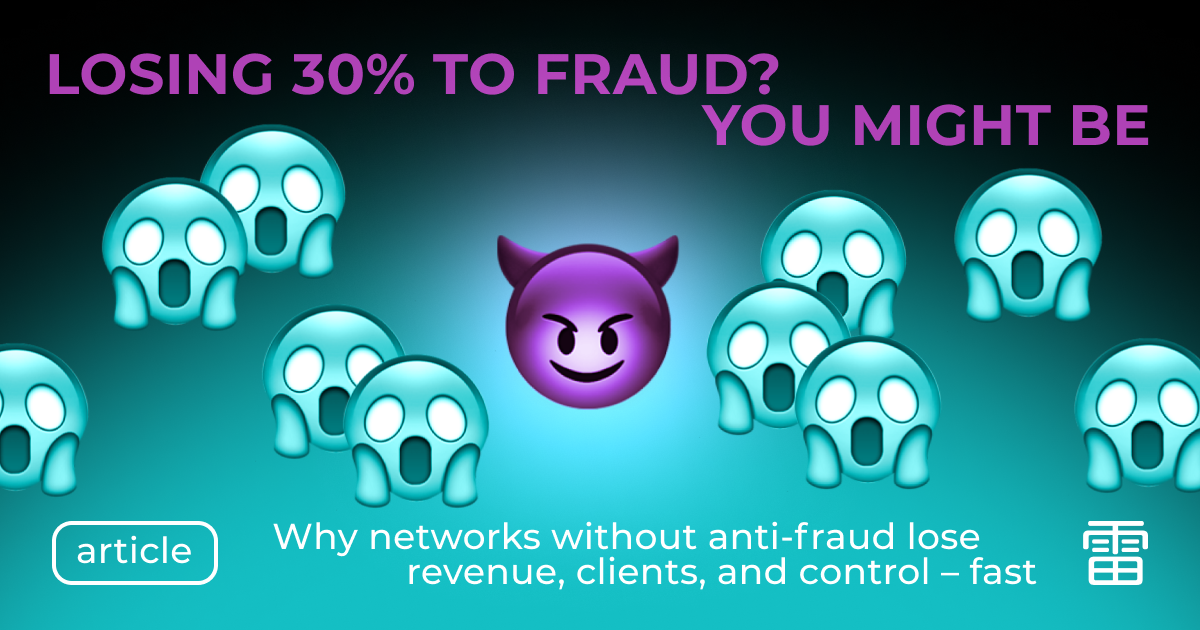If you run an ad network and still don't have an integrated anti-fraud system, you're losing money. Not hypothetically—actually. Right now.
Want to see how much fraud is costing your network? Book a demo call with a Kaminari Click expert—we'll show you the numbers.
Why Fraud Is a Systemic Threat to Affiliate Networks
The affiliate industry is growing rapidly. Along with that growth comes an increasing number of platforms, traffic sources, and participants. But as the market scales, so does the risk: networks lacking solid infrastructure are easy targets for fraudsters.
Fraud in affiliate marketing isn’t just about obvious bots or click farms. It’s about silent leaks: inflated leads, duplicate submissions, fake conversions, spoofed devices, and artificially generated traffic.
Market data shows that 15% to 30% of all traffic in affiliate networks may be fraud. If it isn’t filtered out, the network suffers financial and reputational losses:
- Paying for “leads” that never convert
- Advertisers cutting ties due to low-quality traffic
- Loss of trust among partners and affiliates
- Distorted analytics and broken optimization models
How Exactly Networks Lose Revenue
1. Overpaying for invalid leads
Without proper anti-fraud in place, all incoming leads are treated as legitimate. If your system relies on auto-approval or on postbacks from advertisers without additional validation, a large percentage of leads could be worthless—and you're still paying for them.
2. Decreased ROI for advertisers
Traffic quality has a direct impact on an offer’s return on investment. If your traffic sources are consistently delivering fraud, you’re not just losing conversions—you’re losing the advertiser entirely.
3. Payout disputes and losses
Advertisers may reject up to 30–40% of traffic flagged as suspicious. But you’ve already paid affiliates. That gap comes out of your margin.
4. Internal inefficiency and operational chaos
Without a robust anti-fraud system, your team ends up manually reviewing logs, tracking sources, chasing click IDs—an error-prone and unsustainable process when traffic scales.
Curious how much this applies to your network? Book a demo—we’ll show you exactly where the money is leaking.
Why “External” Anti-Fraud Tools No Longer Cut It
Many networks still rely on third-party fraud detection services via API integrations. These tools operate on generic rule sets: block suspicious IPs, reject actions that don’t fit standard behavior models.
But these solutions don’t understand your specific traffic. They don’t adapt to your verticals, partners, or dynamics.
In practice, you either get:
- lenient filters that let fraud slip through
- or overly aggressive filters that block real users
Anti-fraud must be embedded in your tracking—not layered on top. Only then can you respond quickly, accurately, and predictably.
How Kaminari Click Solves This Differently
Our system uses a multi-layered defense model:
- Ping-stage validation at the very first click event
- Session analysis including timing, behavior, browser, and referrer
- Parameter validation (device ID, IP, user agent, geo)
- Behavioral scoring to assess lead quality holistically
- Real-time BI dashboards for full visibility of suspicious activity
All questionable actions are logged, segmented, and accessible in real time through the dashboard. You see exactly what’s happening—and can act immediately.
Results From Our Clients
– A network in the dating vertical reduced fraud from 28% to 6% in two weeks
– A finance offer saw an 18% increase in CR after cutting off low-quality sources
– The analytics team reduced reconciliation time by 4x by automating fraud detection
Conclusion
Affiliate networks that don’t filter traffic are effectively operating blindfolded. Every day they lose:
- Revenue
- Advertisers
- Partner trust
- Control over operations
In 2025, fraud is no longer a technical nuisance. It's a competitive differentiator—if you know how to stop it.
Kaminari Click offers more than just fraud protection. We offer a traffic quality strategy.
Request a demo call—and let us show you how to take back control, protect your budget, and scale your network on clean data.

